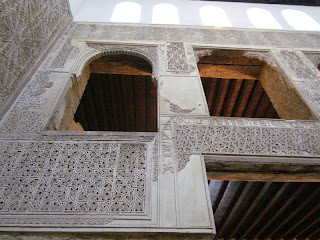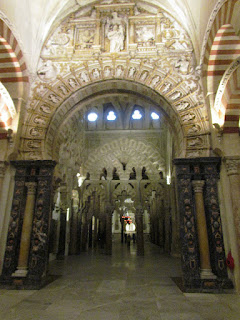Cordoba was a bitter sweet visit for me. It was a pretty town but it was also my last stop on my Spain travels. That and the fact that it was raining so it made it rather difficult to properly sight see. But lucky for me I like the rain so I didn’t mind walking around in it too much.
I got to Cordoba just as the sun was setting. And I caught the right bus to city centre but got off at the wrong stop. So I whipped out my phone and mapped it back to my hostel. It was here at my hostel that I had my very first and only language crisis. I had booked my hostel for one night but I decided I wanted to stay an extra one. The girl who checked me in only knew a tiny bit of English and I know like 0 Spanish. So I was at a loss for what to do. We got the situation resolved when she called her boss (I think) and I spoke English to her boss and the her boss spoke Spanish to her and we got it sorted. Lucky for me that was the only crisis I had in Spain. I’d even prepared myself for the worst expecting a lot of language mishaps but I sailed right through with no problem.
The tourist office in Cordoba was fantastic. Lucky for me there was one a three minute walk from my hostel so after check in I popped around there and picked up some info to plan my trip around the city. Turns out there is quite a bit to see and I was excited. So I went to bed quite excited to go about the town the next day.
I had intended to sleep in the next day as I’d been low on sleep since traveling. But my dormmates were all up and moving around early. So I got up and was moving around early too. I was ready and out by 10h00. My first planned stop was going to be the Cathedral-Mosque. It was €8.50 to get in during the day but free between 9h30 and 10h30 but you had to be silent. So I decided it was best to save money and get up early. So I walked on to my first main visit the Fortress of the Christian Kings. Normally it’s €6 to get in. I paid nothing because it’s free on Wednesdays. Here’s the history paraphrased from the sign out front. The fortress was constructed by order of King Alfonso XI in1328 and was the place where Christian Kings stayed whenever the visited Cordoba. The donjon and Leons tower in the main façade are original. The Inquisition tower was added in the 15th century. The Palomas tower is a 20th century reconstruction. There were important things planned in the fortress like the discovery of America and the reconquest of Granada. During the modern age it was the seat of the Inquisition. In the 19th century it was used as a prison building. It was bought by the city council and restored in the 20th century.
Climbing to the top of the tower made for a great view!
Surprisingly there’s a lot of Roman things to see. Like
The Roman Bridge- I had a grand stroll across some of it.
The Roman Temple remains - sorry for the bad picture but the bars were annoying
The Roman Mausoleum - again shitty picture. But this was depressing to see because it was right next to the road.
The city is home to 12 Christians churches that were to built (many as transformations of mosques) by Ferdinand III of Castile after the reconquest of the city in the 13th century. I saw 2.
San Nicolás de la Villa
San Miguel
There are also other style churches. Like
San Francisco
Chapel of San Bartolomé
Scattered throughout the city are ten statues of Archangel Raphael, protector and custodian of the city. These are called Triumphs of Saint Raphael and are located in landmarks such as the one I saw by the Roman Bridge
And in Plaza del Potro
If I had known this before I would have gone on a hunt for them but I only just found this our while researching for this post.
Jardines de Colón was one of my last stops as I walked toward the bus station.
I also passed the Church and former Palace/Convent of La Merced Provincial Government. That’s a hell of a mouth full. But it was pretty.
Andalusi House
This place was totally cool it was right down the street from the Synagogue. And this is where they used to make paper during the caliphate in the 12th century. Caliphate is an Islamic government system as an fyi. They made their paper with rags. Cool right?
The Synagogue
This is paraphrased from the sign again. It was built in 1315. After the expulsion of the Jews in 1492 it is one of only three remaining synagogues in all of Spain. After the Jews left the synagogue was used as a verity of things. In 1492 the synagogue was used as the Saint Quiteria hermitage and the house as a hospital for hydrophobic people. In 1588 it became property of the Shoemakers cooperation. During this time they paneled over the old plasterwork walls and the roof was replaced. In 1884 a pries discovered the old plaster work and a year later it was declared a national monument and they began restoration.
And just a few other places that I saw:
The old city wall and gate
Malmuerta Tower
A super cute courtyard tucked away by the Synagogue
Plaza de la Corredera
And of course I saved the best for last. The Cathedral and former Great Mosque of Córdoba. I really had mixed feeling about this place. On one hand it’s so pretty but on the other it’s got a sad story. But I’ll depress you later.
The site was originally a pagan temple, then a Visigothic Christian church, then the Moors converted it into a mosque and then built a new mosque on the site. After the Reconquista it became a Roman Catholic church, with a cathedral later inserted into the centre of the large Moorish building. The Mezquita is regarded as the one of the most accomplished monuments of Islamic architecture.
The building was begun around the year 600 as the Christian Visigothic church of St. Vincent. Ancient right?
The Great Mosque of Córdoba was used for a verity of purposes during Moorish rule. It served as a central hall for teaching and to manage law and order within al-Andalus during the rule of Abd ar-Rahman.
There are 856 columns made of jasper, onyx, marble, and granite.
That’s a lot. And it’s so impressive to see and to walk around them all. These pillars were made from pieces of a Roman temple that used to be in the same place.
And there’s the courtyard. It was originally unpaved with natural irrigation for the citrus (lemons and limes and the such) palm trees. Today it’s paved…
In 1236, Córdoba was captured by King Ferdinand III in the Reconquista, and the mosque was turned back into a Christian church. Over then next centuries tons of changes were made to the mosque. Chapels were added and during the renaissance a cathedral nave was built right in the middle of the mosque and the minaret was converted to a bell tower. On the bright side the Christian conversions saved the mosque from destruction during the Spanish Inquisition. And it was continually added on until the late 18th century.
And the sad part? As I said it’s one of the most accomplished Islamic architectural feats and yet Muslims aren’t allowed to pray there. They’ve been lobbying to pray there for a few years now but both Spanish authorities and the Vatican have said no. I think it’s sad that it’s a converted Islamic building and they’re not even allowed to pray there when it’s original purpose was for them to pray.
To leave you on a happier not I have some more Cathedral-Mosque pictures.
Cheers,




























































No comments:
Post a Comment